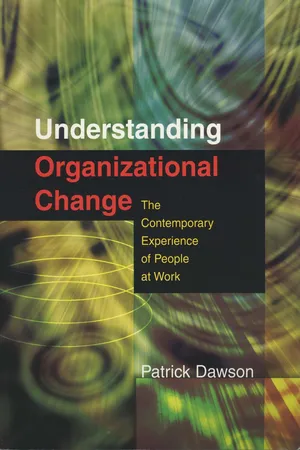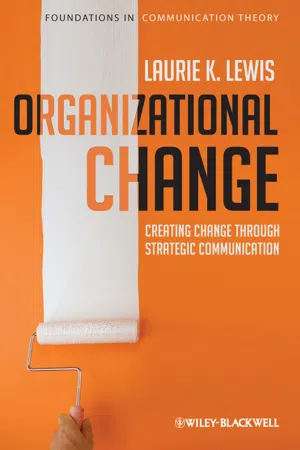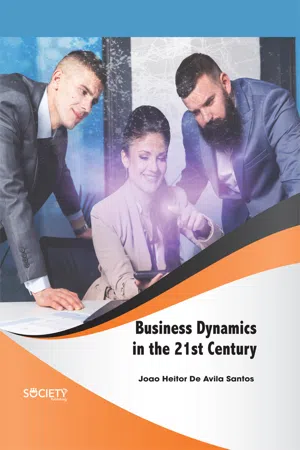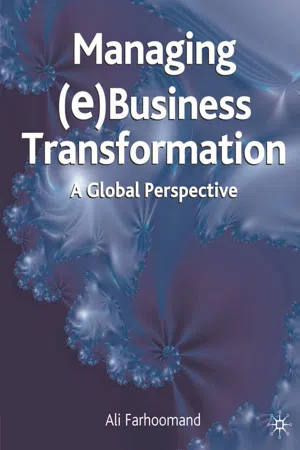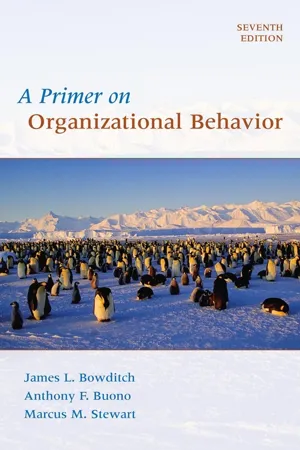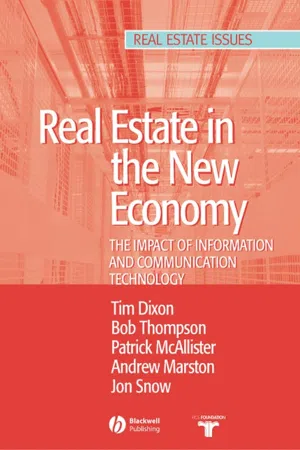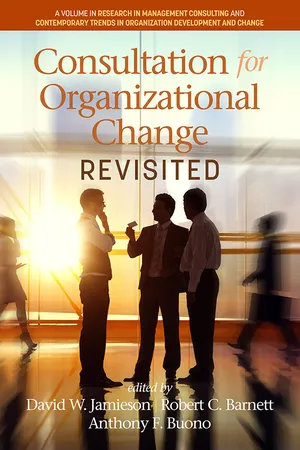Business
Organizational Change
Organizational change refers to the process of making significant alterations to an organization's structure, processes, or culture. It often involves implementing new strategies, technologies, or ways of working to improve performance, adapt to market conditions, or address internal challenges. Effective change management is crucial for ensuring successful implementation and minimizing resistance from employees.
Written by Perlego with AI-assistance
Related key terms
1 of 5
11 Key excerpts on "Organizational Change"
- eBook - PDF
Understanding Organizational Change
The Contemporary Experience of People at Work
- Patrick Dawson(Author)
- 2002(Publication Date)
- SAGE Publications Ltd(Publisher)
But first, it is important to address the question: What do we understand by the term ‘Organizational Change’? PERSPECTIVES ON Organizational Change At its simplest, Organizational Change can be defined as new ways of organizing and working, but as we shall see, much more is tied up with the concept of Organizational Change than this simple definition might at first suggest. As a growing area of study, Organizational Change has many of its theoretical roots in organization theory. For example, the conceptual devel-opments of a number of modern management initiatives (such as knowledge management, the learning organization and best practice management) draw on an existing body of social science research to formulate ‘new’ approaches to change management. An essential concern is how best to organize the activities of employees to ensure that the goods or services provided by the company have a value in the market place. The pursuit of profit by private sector firms and the push for ‘service excellence’ by many public sector organizations oblige management to identify and implement new ways of organizing and working that can best harness employees’ capacity to work. Typically, it is not simply the quantity of work that is important but also the quality. Where raw materials account for a high percentage of total operating costs, knowing when not to work (as in Just-In-Time [JIT] management) and when to tackle a recurring operational problem can be more important than the quantity of output (as evident under the old mass manufacturing piece-rate payment systems). Winning the hearts and minds of employees has also been seen as an important element in ensuring a committed and productive workforce. Different theories and change initiatives have emerged to tackle these issues. - eBook - PDF
Organizational Change
Creating Change Through Strategic Communication
- Laurie Lewis(Author)
- 2011(Publication Date)
- Wiley-Blackwell(Publisher)
Zorn et al. define change as referring “to any alteration or modification of organizational structures or proc- esses” (1999, p. 10). This and other definitions of change often imply that there are periods of stability in organizations that are absent of 26 Defining Organizational Change change or that a normal state for organizations is marked by routine, consistency, and stability. Although stakeholders may experience organ- izations as more familiar and stable at some points and as more dis- rupted and in flux at other points, we can certainly observe that organizing activity is made up of processes and as such is always in motion and always changing. This book is concerned with planned change and periods in organizations where purposeful introductions of change are made in some bracketed moment in the flow of organizing activities. That is, managers and implementers attempt to disrupt what is normal and routine with something else. The process of implementing change in organizations sometimes begins with processes of innovation and diffusion and nearly always involves a formal adoption process and implementation. Innovation is a creative process of generating ideas for practice. Organizational Changes are sometimes generated through accidental or intentional innovation processes used by organizations to create new ways of doing or new things to do. However, organizations don’t always choose to change based on a self-generated idea. Sometimes, as noted earlier, pressures from environment drive changes or changes are spread through a network (e.g., professional associates) or within a particular context (e.g., industry). - eBook - PDF
- Joao Heitor De Avila Santos(Author)
- 2020(Publication Date)
- Society Publishing(Publisher)
Beginning from this description of the organization, the following observations about Organizational Change come to light: • The hierarchical task managers who decide on Organizational Change and implementation; • The resistance to change will be created, and this must be well handled in order to be defeated; and • The change must be well prepared and regulated in order to be successfully implemented. 8.1.3. Organization as Transformation Systems The resemblance of transformation systems in organizations describes how changes take place in a chaotic environment. The principal characteristics of this approach are the following? • The change is due to chaos; • These organizations can reorganize themselves; • Classical organizational structure (based on team hierarchy) is just one of the many dimensions of organizational life. This approach determines the following assumptions about the change: • Managers are part of the systems they manage or are involved in them; • Change cannot be managed because is not determined, it appears; • Tensions and conflicts cause change and characterize the changes that are under development. Business Dynamics in the 21st Century 242 8.1.4. Importance of Change Management in Organizations Change can be described as a transition from one condition to another. Organizations may need to adjust with the main motivation to improve efficiency. Change management is, therefore, the ability to make this change using the proper resources, tools, strategies, and preparation that would bring significant benefits to the company. Via change management, people are directed and encouraged to agree and prepare to make changes to the company. Change management is an orchestrated strategy to help the company transition from the current state to the planned future state. The key success of any change process depends on how well the company’s employees support the transition. - eBook - ePub
Work, Change and Competition
Managing for Bass
- David Preece, Gordon Steven, Valerie Steven(Authors)
- 2002(Publication Date)
- Routledge(Publisher)
5 Change and changing
There are a number of matters which will be discussed in this main section. We will begin by distinguishing between what is meant by ‘change’ and ‘changing’; this is followed by an overview of ‘strategic’ or, as it is sometimes called, ‘planned’ change and some of the ways in which such change can begin. The foregoing necessarily draws upon a consideration of Organization Development (OD), and so something will be said here about the nature of OD, before addressing some of the main problems associated with this perspective on Organizational Change. Following this critique, the narrative moves away from OD to consider alternative frameworks for studying Organizational Change, labelled ‘emergent’ or ‘processual-contextual’. On the basis of this discussion of OD and Organizational Change, the narrative then turns to an examination of the people who take on a responsibility for change within organizations (‘change agents’).Clearly it is an impossible task to outline and discuss all the variety of forms which Organizational Change can take, such as cultural, structural, redesign of jobs, introduction of new working practices, changes to grading and remuneration systems, and changes to the modes of control. The nature and implications of any and all of these changes will vary both across different organizations and within the same organization over time. Given that the central focus of the book is upon a detailed outline and analysis of the many facets of a major strategic change initiative in a particular organization, we decided to elaborate more fully upon each of the aspects of the change process at the point at which they are addressed in the book, rather than in this chapter.Change versus changing
Brunsson and Olsen (1993) talk about what they refer to as ‘administrative reform’, and ask why reform projects are so common, given that they often do not involve any Organizational Change. One response they provide to this question is that ‘reforms are easier to initiate than to decide on, and easier to decide on than to implement’ (1993:6). Another is that the employees on the ‘receiving end’ of the reforms do not support them because they recognize that they are based on faulty premises, are self-contradictory, or destructive. It may sometimes make sense for senior managers to ‘boast’ that certain reforms have occurred in order to display their ‘rationality’ and up-to-dateness to outsiders; indeed, there may only be a certain repertoire of ‘reforms’ which are so perceived during a given time period, hence the ‘choice’ may be restricted. What is more, ‘The existence and change of external norms may be the very reason for reform. When fashion swings, organizations must change their forms if they are to be considered normal and up-to-date’ (1993:8). Why does this happen? - eBook - PDF
Managing (e)Business Transformation
A Global Perspective
- Ali Farhoomand, M. Lynne Markus, Guy Gable, Shamza Khan(Authors)
- 2021(Publication Date)
- Red Globe Press(Publisher)
In the process, we introduce a conceptual framework to show the intricate dynamic interplay among the major organizational dimensions: strat-egy, structure, processes, people, and technology. We start the chapter by probing the question of what actually constitutes success in an e-business effort. We then proceed with a discussion of why so many organization transformation initiatives fall short of achieving success. Specifically we discuss the reason behind the failure of two very popular transformation efforts – total quality management (TQM) and business process reengineering (BPR). Because of the ambiguities ingrained in today’s business lexicon, we then provide a brief introduction to the concepts of chaos, complexity, and complex adaptive systems with a view to highlighting their implications for e-business transformation. Next we discuss the steps involved in organizational transformation. This is followed by an introduc-tion of the Dynamic Organizational Tension (DOT) framework. We use this framework to show how companies walk “at the edge of chaos” by main-taining dynamic tension among major forces within and outside their organi-zational bounds. We show that in order to manage e-business transformation successfully, companies need to strike a balance between their desire for stability, 2. American Heritage Dictionary defines the term change as “[t] the act, process, or result of altering or modifying”, and the term transformation as “[a] marked change, as in appearance or character, usually for the better”. Change and transformation in business 3 on the one hand, and the destabilizing forces in the market, on the other. Understanding the tradeoffs involved in this as well as other paradoxes is of paramount importance in transformational initiatives. Success: a moving yardstick Success: The accomplishment of what was aimed at. – Oxford English Dictionary Success: The favourable or prosperous termination of attempts and endeavours. - Jaap Boonstra(Author)
- 2008(Publication Date)
- Wiley(Publisher)
Rarely does the organizational context remain stable enough for us to genuinely evaluate success or failure. As I write this chapter, I have just completed the review of an internal report from a senior executive of a global company with which I have been working. His company is concerned that they are not achieving the rate of change required of world-class companies in that sector. I was struck by part of his diagnosis which reads as follows: Current change methodologies are employed within functional silos and the informal way in which strategy is cascaded through various differentiated groups and departments dilutes the value of the strategy . . . [which] should be focused on understanding how the business processes deliver overall enterprise value . . . [the company] needs to develop a process for implementing strategic improvement ideas in those value streams. This quote captures two or three ‘big’ ideas about change. First, that many change programmes ‘fail’ because they are implemented within a part of the organization—there is an absence of an integrated approach as between divisions, departments, and the like. Second, that successful change may best be achieved by focusing change efforts horizontally, i.e. along the customer value stream rather than vertically up or down the structure. This idea does not vitiate all notions of bottom-up, top-down, and cascading change programmes which you will have read about, and experienced and/or managed, but it does provide a different perspective when thinking about change. Another ‘big’ idea is that of organizational learning, whether in the context of strategy, manage-ment development, organizational development, or major change. Many practitioners and consul-tants/researchers point to the vital role of organizational learning in a period of change.- eBook - PDF
- James L. Bowditch, Anthony F. Buono, Marcus M. Stewart(Authors)
- 2015(Publication Date)
- Wiley(Publisher)
The feeling of being in “permanent white water” and the need to constantly adapt and adjust can be a daunting experience. 95 Many people ultimately want Organizational Change to end, rather than experience changing as a way of doing business that will, in essence, never end. Enabling Large-Scale Organizational Change A critical challenge for twenty-first-century organizations and their leaders is the on- going development of individuals, teams, and entire organizations that are capable of understanding these different approaches to change and adapting the change pro- cess to the complexity and uncertainty of the situation. From this perspective, the highest level of change capacity would be exemplified by an organization in which these different approaches to change—directed change, planned change, and self- organizing, guided changing—are implemented as appropriate in different situations with the full support and commitment of all organizational members because they understand the different approaches to change and challenges of change manage- ment. Once a large-scale change has been envisioned, a number of related issues emerge that concern needed support for the actual implementation of the change. Six key enabling factors should be considered in formulating a context for the implementation of any significant change: 96 1. Issues of pace focus on the length of time necessary to actually design and implement the change program, how quickly the change itself should unfold given relevant external pressures (e.g., customer demands, competitive pressures), how much adjustment should be allowed for trial-and-error learning, and the appropriate mix of big and small changes. 2. Questions of scope emerge directly from the vision of the change, and center on whether the change should “start small and grow” (e.g., through a pilot program) or be instituted organization-wide. - eBook - PDF
- Michael A. Hitt, C. Chet Miller, Adrienne Colella, Maria Triana(Authors)
- 2017(Publication Date)
- Wiley(Publisher)
478 CHAPTER 14 Organizational Change and Development the negative outcomes that the organization and its managers and associates will suffer if changes are not made (e.g., areas where new resources are needed). 52 Third, leaders create a sense of psychological safety concerning the change. Managers and associates must believe they can successfully change. 53 Tactics that change leaders might use include the following: • Reminding individuals that they have successfully changed in the past • Communicating to individuals that managers and associates in other organizations in similar circumstances have successfully changed • Explaining to individuals that support and training will be available for the specific changes to be made • Ensuring that individuals also maintain some stability while also participating in the change Transforming Transforming involves three key activities: providing information needed for the changes; removing obstacles to change; and implementing the changes. 54 First, change leaders must provide information and evidence that supports the proposed changes. Without supporting information, managers and associates may not have faith in what they are being asked to do, and will be less committed to it. Pilot tests, outside experts, and data on how others have benefited from similar changes can be effective tactics. Furthermore, as noted in our discussion of transformational leaders in Chapter 8, a compelling vision of the future also can be useful in building commitment to proposed changes. Indeed, such a vision is likely to be crucial for creating change. Second, potential constraints to making the change must be eliminated or overcome by change leaders. This might require investing more money to reduce financial constraints or providing more training to improve associates’ capabilities to make the change. 55 Third, change leaders must be able to shift behavior and implement the change. - eBook - PDF
Real Estate and the New Economy
The Impact of Information and Communications Technology
- Tim Dixon, Bob Thompson, Patrick McAllister, Andrew Marston, Jon Snow(Authors)
- 2008(Publication Date)
- Wiley-Blackwell(Publisher)
4 Business Process and Organisational Change Introduction Without making any judgement as to better or worse, there is virtually no commercial organisation or individual that has not been changed in some way by the application of ICT. The primary purpose of this chapter is to look at the practical mechanisms through which these changes in ICT affect the real estate industry. In order to meet this objective the chapter examines how change happens in organisations, and looks at some potential reasons why it never happens as quickly, or as comprehensively, as its proponents expect. We discuss the management context of business processes and some of the high-profile models and techniques that have been espoused for their optimisa-tion. Next, the chapter examines the role of ICT in the design of organisa-tions generally and draws out the scale and nature of the ICT-enabled changes that have already occurred. The chapter then identifies how ‘busi-ness’ is structured, breaking it down into a generic set of business pro-cesses that govern how things are done. Further, the chapter analyses how ICT has changed the fundamental business models underlying organisa-tions and identifies changes to property that accrue from them. Finally the chapter discusses the mapping of these business processes onto real property and the potential impacts that may accrue from changes. Understanding corporate change In the 1980s and 1990s planned change at the process level was predicated upon the assumption that structures, processes, ICT, skills and knowledge could all be reconfigured to optimise the achievement of strategic goals. Typically these approaches were given snappy acronyms such as, for example, BPR (business process re-engineering) or TQM (total quality management). - eBook - PDF
Strategy and Performance
Achieving Competitive Advantage in the Global Marketplace
- A. Ghobadian, N. O'Regan, D. Gallear, H. Viney, A. Ghobadian, N. O'Regan, D. Gallear, H. Viney(Authors)
- 2003(Publication Date)
- Palgrave Macmillan(Publisher)
Employees and customers are two of the most important determinants for the way business is conducted now and in the future. Managers should know how to use management tools and technol- ogy creatively, so that they produce market-perceived value in a cost- effective way. This requires multidisciplinary people who practice up-to-date customer service skills. Many successful corporations have abandoned hierarchical structures and are organizing themselves in new ways to discover and deliver ‘market-perceived value’. Such corpo- rations have foregone traditional thinking about the role of the centre as a directing force (Quinn et al. 1996). Quo vadis? The respondents agreed that many organizations were in transition. Almost every aspect of the industrial paradigm seems threatened. There is a recognition of the need to move from a hierarchical functional management approach to a cross-functional process. Goodman 199 A change programme leads to changes in behaviour. The level and depth of behaviour change will therefore correspond to the shift in indi- vidual familiarity (Porras and Silvers, 1991). Change cannot be executed without implicitly addressing the corresponding affect on the people in the organization. The interrelationships of people, organizations, cul- ture and technology are such that changes in the environment require: • changes in vision, work culture and value ... which require • changes in skill and competencies at all levels ... which require • changes in process, resource allocation and other organizational levers ... which lead to • management of the integrated enterprise and valued outcomes. This chapter acknowledges that individuals are becoming the cur- rency of the future and that leadership should be visionary. In an uncer- tain future, managers should respect their employees and leaders should shape organizational responses. A company with both attributes is in a better position to create a strong unified culture with a shared vision. - David W. Jamieson, Robert C. Barnett, Anthony F. Buono(Authors)
- 2017(Publication Date)
- Information Age Publishing(Publisher)
They have their fingers on the pulse of employee satisfaction, customer loyalty, and other stakeholder perceptions. • There is an increasing appreciation for the importance of design in shaping behavior, and a capacity to make continual design changes, large and small, that flexibly align resources and behavior with needed organizational capabilities. Far from seeking uniformity, ef- fective change in a rapidly evolving environment recognizes that all designs are temporary and that strategic alignment does not require monolithic organizational systems, processes, and structures. Instead, change efforts arrange unique, valuable, and difficult-to-replicate re- sources to support learning from and building on diversity. Solution- based, global, and other complex strategies require more coordina- tion and collaboration than the competitive strategies of the 1980s. • Organizations continually tailor their designs and interventions as necessary to implement a strategy. Today’s transformations cannot be controlled and programmed from the top. Creating targeted, specific, high impact interventions that “perturb” the system and set the conditions for self-organizing are increasingly relevant. Even well designed and defined Total Quality Management (TQM) and Six Sigma processes cannot be “cut and pasted” into the organi- zation without tailoring. Change of the magnitude, speed, and diversity required today cannot be carried out without considerable emergent change and self-regulation through the organization. Because of the complexity and the interdependencies in the system, an important change challenge is to catalyze sufficient information exchanges across the system. This allows interdependent change activities to adjust to and influence one another. • Organizations monitor the effect of organization changes on desired outcomes, understand the organization’s progress in achieving its strategy, and make rapid adjustments based on what is learned.
Index pages curate the most relevant extracts from our library of academic textbooks. They’ve been created using an in-house natural language model (NLM), each adding context and meaning to key research topics.
